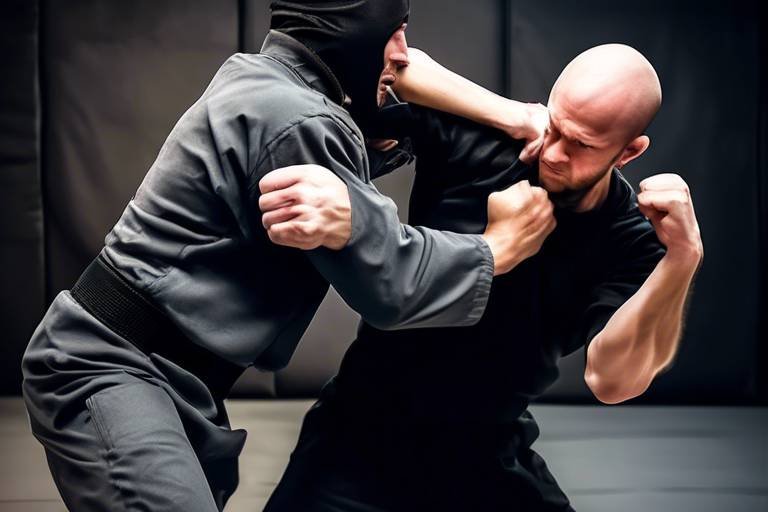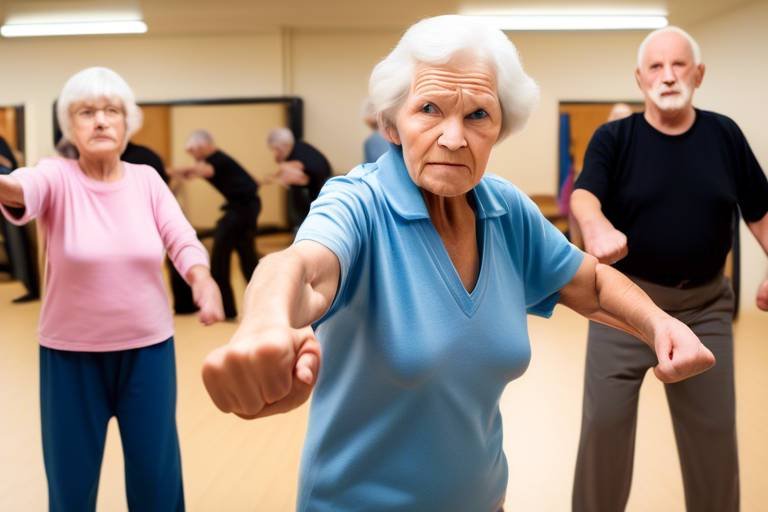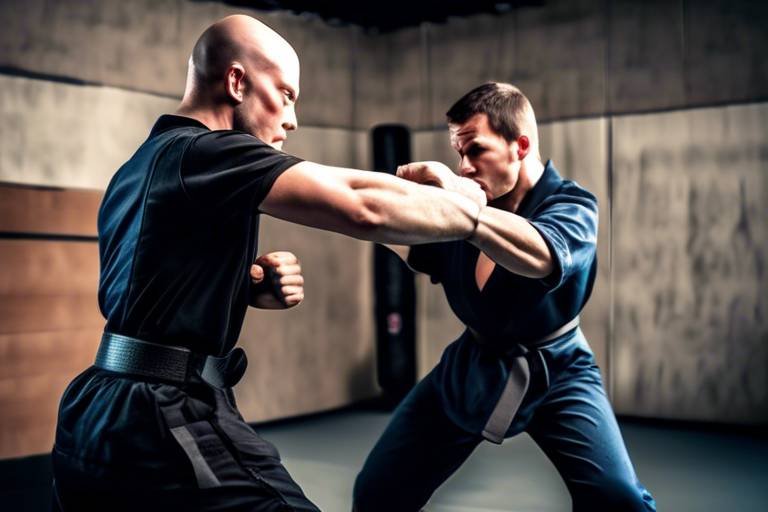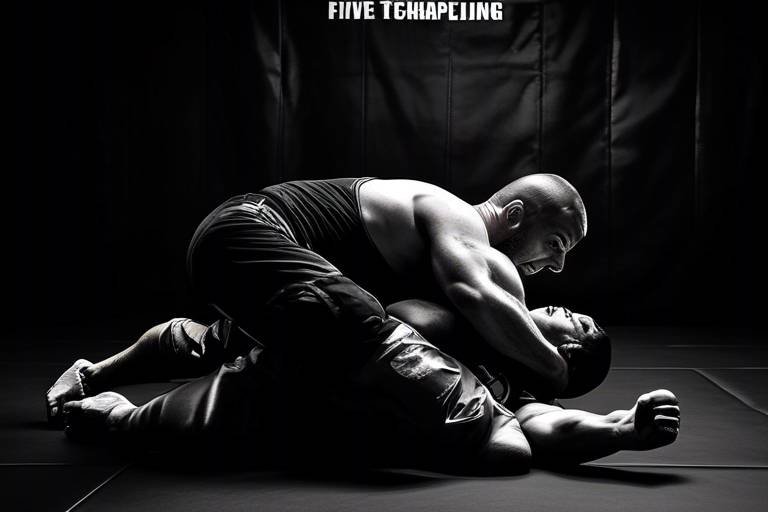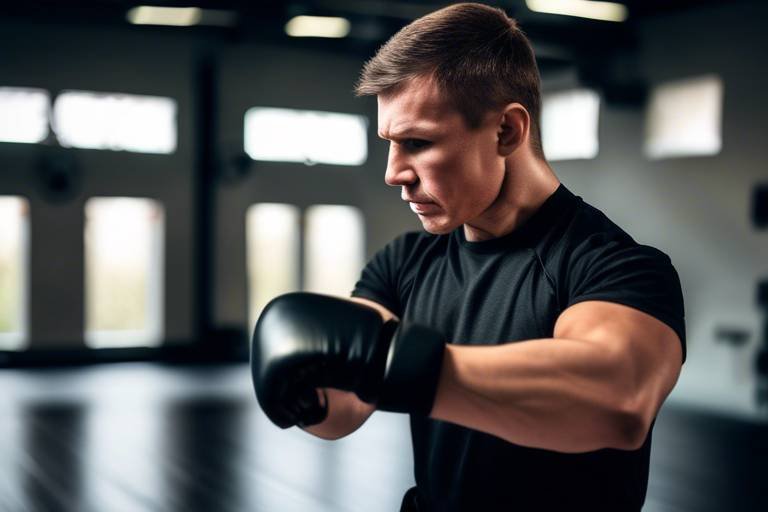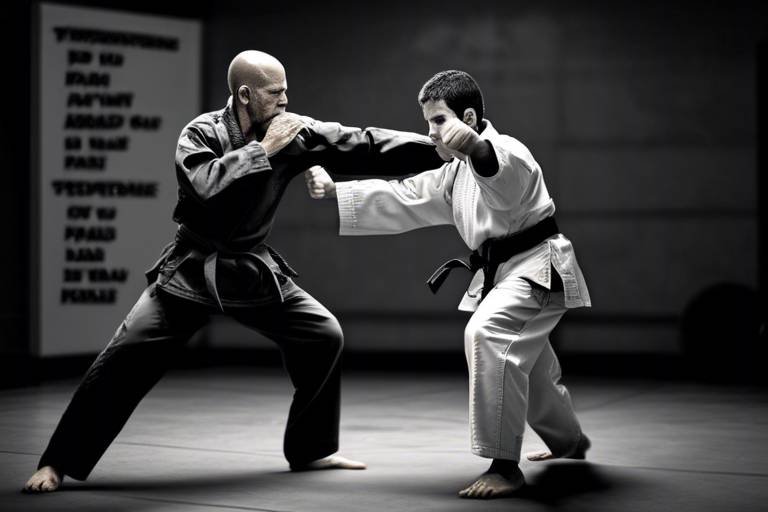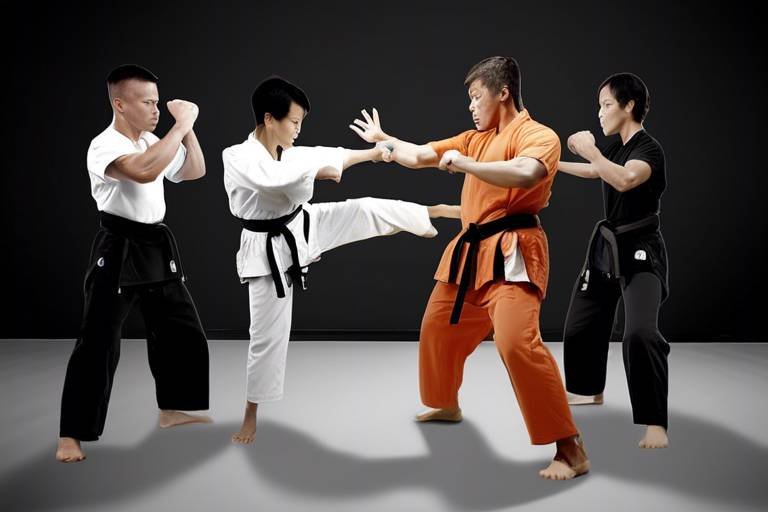Block, Strike, Evade - Core Aspects of Self-Defense Techniques
In a world where personal safety is paramount, understanding the core aspects of self-defense techniques can be a game-changer. Whether you're walking home late at night or simply want to feel more empowered in your daily life, mastering the skills of blocking, striking, and evading can make all the difference. Think of these techniques as your personal safety toolkit; each one serves a unique purpose, and when combined, they create a robust defense mechanism against potential threats. Let's dive deeper into these essential components of self-defense and discover how they can help you stay safe and confident.
Blocking is often the first line of defense in self-defense scenarios. Imagine your body as a shield, absorbing or deflecting incoming attacks. The beauty of blocking lies in its versatility; you can use your arms, legs, or even your entire body to protect yourself. By understanding the mechanics of blocking, you can minimize injury and create openings for counter-attacks. It's not just about stopping an attack; it's about turning the tables in your favor. For instance, a well-timed block can lead to a swift counter-punch, shifting the momentum of the confrontation.
Striking is where the action really heats up. This technique encompasses a variety of offensive moves designed to incapacitate an attacker. Think of striking as your way of saying, "Not today!" to any potential threat. The effectiveness of a strike hinges on three main factors: precision, power, and timing. It's not just about hitting hard; it's about hitting smart. The right strike at the right moment can make all the difference in a self-defense situation.
When it comes to striking, there are several techniques to consider, each with its own set of advantages. Here are some common types of strikes you can incorporate into your self-defense repertoire:
- Punches: Quick and powerful, perfect for close encounters.
- Kicks: Offer longer reach and can target vulnerable areas.
- Elbow Strikes: Effective in close quarters, utilizing the body's natural weapons.
Understanding these different types of strikes allows you to adapt your approach based on the situation at hand. Some might be more effective in certain scenarios, so knowing when to use each technique is crucial.
Punching is a fundamental striking technique that can deliver significant force. To maximize the effectiveness of your punches, focus on proper form and targeting. A common mistake is to throw punches without proper alignment, which can lead to injury or ineffective strikes. Remember, a well-placed punch to the jaw can incapacitate an attacker, but only if executed correctly. Practice makes perfect, so don't shy away from honing your punching skills!
Kicking techniques are another essential aspect of striking. They allow for a longer reach and can target vulnerable areas such as the knees, groin, or head. Consider practicing various kicks, such as the front kick or roundhouse kick. Each kick serves a unique purpose, and mastering them can give you a significant advantage in a self-defense situation. Just like a well-placed punch, a powerful kick can change the dynamics of a confrontation.
Mastering timing and distance is crucial for effective striking. Think of it as a dance; if you can gauge the right moment to strike, you can enhance your safety and effectiveness. Maintaining optimal distance from an attacker allows you to strike without putting yourself in harm's way. Practice gauging distances and timing your strikes to ensure that you're always a step ahead.
Evading is an equally important aspect of self-defense. Instead of confronting an attack head-on, evasion techniques allow you to avoid danger altogether. This can be achieved through footwork and body movement, enabling you to escape potentially harmful situations without physical confrontation. Imagine being like a leaf in the wind, gracefully dodging any incoming threats.
Good footwork is the backbone of effective evasion. It keeps you mobile, balanced, and ready to react. Think of your feet as the wheels of a car; they need to be in top shape to navigate through any terrain. Practicing footwork drills can significantly improve your self-defense capabilities, allowing you to maneuver quickly and efficiently.
Body movement techniques, such as ducking and weaving, are essential for avoiding strikes. These movements can be seamlessly integrated into your self-defense strategy, helping you dodge attacks and create opportunities for counter-attacks. Picture yourself as a skilled boxer, moving fluidly to avoid punches while waiting for the perfect moment to strike back.
Q: How can I start learning self-defense techniques?
A: There are many ways to begin your self-defense journey. Consider enrolling in a local self-defense class, watching instructional videos, or practicing with friends. The key is to start practicing regularly.
Q: Do I need to be physically fit to learn self-defense?
A: Not necessarily! While being fit can enhance your abilities, self-defense techniques can be adapted for all fitness levels. Focus on technique and practice to build your skills over time.
Q: What should I do if I find myself in a dangerous situation?
A: Always prioritize your safety. If you can, try to escape the situation. If confrontation is unavoidable, use the techniques you've learned—block, strike, and evade as necessary.

Understanding the Block
Blocking is a fundamental self-defense technique designed to protect oneself from incoming attacks. Imagine standing in front of a wave; if you don’t brace yourself, you’ll be knocked over. Similarly, blocking acts as your personal shield against potential harm. It involves using various parts of the body—like the arms, forearms, and even legs—to deflect or absorb strikes, thereby minimizing injury and creating opportunities for counter-attacks. The beauty of blocking lies in its versatility; it can be adapted to various situations, whether it’s a punch, kick, or any other form of assault.
When you think about blocking, it’s essential to understand that it’s not just about physical defense; it’s also a mental game. You need to be aware of your surroundings and anticipate the movements of your attacker. This awareness can make the difference between a successful block and a painful hit. A well-timed block can not only protect you but also set the stage for an effective counter-strike, turning the tables on your assailant.
There are different types of blocks, each with its own purpose and effectiveness. Here are a few common blocking techniques:
- High Block: Used to defend against strikes aimed at your head or upper body.
- Low Block: Effective against low kicks or attacks directed at your legs.
- Inside Block: Used to deflect incoming punches from the side.
- Outside Block: Helps to protect against attacks coming from the outside angle.
Each of these techniques requires practice to execute correctly. For instance, the high block is not merely about raising your arms; it’s about positioning your body in a way that absorbs the force of the strike while keeping your balance intact. The key to mastering these blocks lies in understanding your body mechanics and practicing regularly. This way, when the moment arises, your movements will be instinctive and fluid.
Moreover, blocking is not just a reactionary measure; it can also be a proactive strategy. By anticipating an attack, you can position yourself in a way that allows for an efficient block, followed by a swift counterattack. It’s like a dance—timing and rhythm play crucial roles in ensuring that you stay one step ahead of your opponent. So, the next time you think about self-defense, remember that blocking is your first line of defense, and mastering it can be a game-changer in critical situations.

The Art of Striking
Striking is not just about throwing punches or kicks; it’s an art form that requires precision, power, and timing. When you find yourself in a potentially dangerous situation, knowing how to strike effectively can make all the difference in ensuring your personal safety. Think of striking as a dance; it requires rhythm and coordination, where each movement is intentional and calculated. The goal is to incapacitate your attacker while minimizing the risk to yourself.
To master the art of striking, one must understand the various techniques available. Each technique has its own unique advantages, and the effectiveness often depends on the context of the situation. For example, a well-placed punch can be a game-changer in close quarters, while a powerful kick can keep an aggressor at bay. The key is to adapt your striking technique based on the scenario at hand.
When it comes to striking, there are several types to consider. Here’s a quick overview:
- Punches: These are the most common strikes, utilizing the fist to deliver forceful blows to an opponent.
- Kicks: Kicking techniques can create distance and target vulnerable areas, making them a versatile option.
- Elbow Strikes: These are particularly effective in close-range situations, where a punch may not have the same impact.
Each type of strike requires specific techniques to ensure they are executed effectively. For instance, when delivering a punch, proper form is crucial. You want to ensure your wrist is straight, your elbow is aligned, and your shoulder is engaged. This not only maximizes the power of your strike but also helps prevent injuries to yourself. Similarly, kicking techniques should involve the use of your hips and legs to generate force, targeting areas like the knees or groin for maximum effect.
Timing and distance are two critical elements that can make or break your striking effectiveness. Imagine you’re in a boxing ring; the moment your opponent moves, you need to gauge the right time to strike. If you wait too long, you might miss your opportunity. Conversely, if you strike too soon, you may leave yourself open to a counterattack. Learning to read your opponent's movements and maintaining optimal distance can significantly enhance your striking capabilities.
In conclusion, the art of striking is about more than just physical strength; it’s about strategy, awareness, and adaptability. Whether you are practicing punches, kicks, or elbow strikes, remember that every movement counts. With dedication and practice, you can develop the skills necessary to defend yourself effectively in any situation.
Q: What is the most effective strike for self-defense?
A: The most effective strike often depends on the situation. However, many self-defense experts recommend focusing on punches and kicks, as they can be executed quickly and with significant impact.
Q: How can I improve my striking technique?
A: Practice is key! Regularly training in a self-defense class or with a partner can help you refine your technique. Additionally, focusing on form, timing, and distance will enhance your effectiveness.
Q: Is it necessary to learn all types of strikes?
A: While it’s beneficial to be familiar with various strikes, focusing on a few that you can execute well is often more effective than trying to master them all. Choose based on your comfort level and the scenarios you might face.

Types of Strikes
This article explores essential self-defense techniques, focusing on the fundamental aspects of blocking, striking, and evading attacks. Each technique is vital for personal safety and empowerment in potentially dangerous situations.
Blocking is a fundamental self-defense technique designed to protect oneself from incoming attacks. It involves using various parts of the body to deflect or absorb strikes, minimizing injury and creating opportunities for counter-attacks.
Striking encompasses a range of offensive techniques aimed at incapacitating an attacker. This section delves into effective striking methods, emphasizing precision, power, and timing to maximize impact and ensure personal safety in confrontational scenarios.
When it comes to self-defense, understanding the different you can use is crucial. Each strike serves a unique purpose and can be tailored to fit various situations. Here are some key types of strikes that anyone interested in self-defense should know:
- Punches: These are one of the most common forms of striking and can be executed quickly. A well-placed punch can incapacitate an attacker by targeting sensitive areas such as the jaw or nose.
- Kicks: Kicking techniques provide a longer reach and can be incredibly effective against an assailant. By targeting the knees, groin, or head, kicks can create distance and give you a chance to escape.
- Elbow Strikes: These strikes are particularly useful in close quarters. The elbow can deliver powerful blows to an opponent’s face or body, often catching them off guard.
Each type of strike has its advantages, and knowing when and how to use them can make a significant difference in a self-defense scenario. For instance, while punches might be more effective in a close-range fight, a well-timed kick can help you maintain distance from an attacker.
Punching techniques are crucial for delivering powerful strikes. To execute an effective punch, it’s essential to maintain proper form. Your fists should be tightly clenched, and you should aim to strike with the first two knuckles for maximum impact. Targeting vulnerable areas like the chin or solar plexus can increase the effectiveness of your punches. Common mistakes include overextending your arm or neglecting to follow through, which can leave you open to counterattacks. Practicing your punches regularly can help you develop the muscle memory needed to react quickly in self-defense situations.
Kicking techniques offer a longer reach and can target vulnerable areas of an attacker. Different types of kicks, such as the front kick and roundhouse kick, can be employed based on the situation. The front kick, for instance, is straightforward and effective for pushing an attacker away, while a roundhouse kick can deliver power from the side, targeting the head or body. It’s important to practice these kicks to ensure accuracy and power, as well as to understand when it’s appropriate to use them. Always remember to keep your balance and control your movements to avoid falling victim to a counterattack.
Mastering timing and distance is essential for effective striking. Understanding when to strike and maintaining an optimal distance can enhance your safety and effectiveness during confrontations. Timing involves gauging the right moment to unleash your strike, while distance refers to the space between you and your attacker. The closer you are, the more vulnerable you may be to their attacks, hence the need to maintain a safe distance until you see an opening.
Evading involves avoiding an attack rather than confronting it directly. This section discusses various evasion techniques, including footwork and body movement, which can help individuals escape dangerous situations without physical confrontation.
Good footwork is crucial for effective evasion. This subsection highlights the importance of mobility, balance, and positioning, providing practical tips for improving footwork to enhance overall self-defense capabilities.
Body movement techniques, such as ducking and weaving, are essential for avoiding strikes. This part covers how to integrate these movements into self-defense strategies, ensuring individuals can dodge attacks and create counter-opportunities.
Q: What should I do if someone attacks me?
A: Stay calm and assess the situation. Use the techniques you've learned, such as blocking or striking, to protect yourself. If possible, try to escape the situation rather than engage.
Q: Are there specific strikes that are more effective for women?
A: Yes, strikes that target vulnerable areas, such as the eyes, throat, and groin, can be particularly effective for women. It's essential to practice these techniques to ensure they can be executed quickly and effectively.
Q: How can I improve my self-defense skills?
A: Regular practice is key. Consider enrolling in a self-defense class or martial arts training to enhance your skills and build confidence in your abilities.

Punching Techniques
Punching techniques are fundamental in self-defense, serving as powerful tools to create distance and incapacitate an attacker. To effectively deliver a punch, it's essential to understand the mechanics involved. The proper form involves aligning your fist, elbow, and shoulder to maximize the force delivered while minimizing the risk of injury to yourself. When you throw a punch, imagine it as a coiled spring; the tighter you coil, the more energy you can release. This energy transfer is crucial for effective striking.
One of the most common mistakes people make is neglecting their stance. A solid stance provides stability and balance, allowing you to generate power from your legs and hips. When you’re in a fighting stance, your feet should be shoulder-width apart, with one foot slightly forward. This positioning not only helps in delivering powerful punches but also aids in quick movements to evade attacks.
When practicing punching techniques, it's vital to focus on targeting specific areas of an attacker's body. Here are some effective target areas to consider:
- Jaw: A well-placed punch to the jaw can knock an assailant off balance.
- Nose: Striking the nose can disorient an attacker and buy you time to escape.
- Solar Plexus: A punch to this area can wind an assailant and incapacitate them momentarily.
In addition to targeting, timing plays a crucial role in the effectiveness of your punches. You must learn to read your opponent's movements and anticipate their actions. This ability to predict can be the difference between landing a punch and getting hit yourself. Practicing with a partner or a punching bag can significantly enhance your timing and precision.
Moreover, the power of a punch doesn't solely rely on strength. It involves technique, speed, and follow-through. For instance, a jab is a quick, straight punch that can disrupt an opponent's rhythm, while a cross is a powerful punch thrown with the rear hand, providing greater force. Understanding the differences between these punches allows you to choose the right one for the situation.
Finally, while practicing these techniques, always remember the importance of safety. Use protective gear when training and ensure you’re in a controlled environment. Self-defense is not just about striking; it’s about being aware of your surroundings and knowing when to engage or disengage.
Q: How can I improve my punching power?
A: To enhance your punching power, focus on strengthening your core and leg muscles, as they provide the foundation for powerful strikes. Additionally, practice your technique regularly to ensure proper form and mechanics.
Q: What should I do if I miss my punch?
A: If you miss your punch, quickly assess the situation. Use footwork to create distance and prepare for the next move, whether it's another strike or an evasion.
Q: Are there specific punches better suited for self-defense?
A: Yes, punches like the jab and cross are often recommended for self-defense as they can be delivered quickly and with precision. The uppercut can also be effective if you’re in close range.

Kicking Techniques
Kicking techniques are a vital component of self-defense, offering individuals the ability to strike from a distance and target key areas of an attacker's body. Unlike punches, which require close proximity, kicks can create space and provide an opportunity to escape or follow up with additional techniques. The beauty of kicking lies in its versatility; there are various types of kicks, each with its own purpose and effectiveness. By mastering these techniques, one can significantly enhance their self-defense capabilities.
One of the most common kicks is the front kick. This technique involves raising the knee and extending the foot forward to strike the opponent, usually targeting the stomach or groin. It’s a straightforward move that can be executed quickly and powerfully, making it an excellent choice for self-defense. Additionally, the front kick can help maintain distance, allowing the defender to create space between themselves and the attacker.
Another effective kicking technique is the roundhouse kick. This kick is executed by pivoting on the supporting foot and swinging the other leg in a circular motion, striking with the shin or the instep. The roundhouse kick is particularly effective for targeting the head or the ribs, and its power can be enhanced by the momentum generated from the pivot. However, it requires practice to ensure proper form and balance, as improper execution can lead to injury or loss of balance.
When practicing these kicks, it's essential to focus not only on the technique but also on targeting. Here are a few key areas to aim for during a kick:
- Groin: A powerful target that can incapacitate an attacker quickly.
- Knees: Striking the knee can destabilize an attacker.
- Ribs: A well-placed kick can wind an opponent and create an opening for escape.
- Head: Aiming for the head can potentially end a confrontation swiftly.
Timing and precision are crucial when executing kicks. A well-timed kick can catch an attacker off guard, while a poorly timed one may leave you vulnerable. Practicing in front of a mirror or with a partner can help improve your accuracy and confidence. Additionally, using a heavy bag can assist in building strength and refining your technique. Remember, it’s not just about the power of the kick but also about the ability to deliver it effectively.
In summary, mastering kicking techniques can significantly enhance your self-defense skills. Not only do they allow you to keep attackers at bay, but they also provide opportunities to incapacitate them if necessary. By practicing regularly and focusing on technique, targeting, and timing, you can become more confident in your ability to defend yourself in potentially dangerous situations.
- What is the most effective kick for self-defense?
The front kick is often considered one of the most effective kicks for self-defense due to its power and ability to maintain distance.
- How can I improve my kicking techniques?
Practice regularly, focusing on form, balance, and targeting. Using a heavy bag or practicing with a partner can help enhance your skills.
- Are kicks safer than punches in self-defense?
Kicks can be safer as they allow you to maintain distance from an attacker, reducing the risk of being hit while delivering your strike.

Timing and Distance
Mastering timing and distance is essential for effective striking in self-defense situations. Imagine you’re a dancer on a stage, where every move needs to be perfectly timed to create a stunning performance. Similarly, in self-defense, your ability to gauge the right moment to strike and maintain an optimal distance from an attacker can mean the difference between safety and danger. Understanding these two elements can enhance your defensive skills and empower you to respond appropriately in confrontational scenarios.
Timing is all about recognizing the right moment to act. It’s not just about being quick; it’s about being smart. For instance, if an attacker is moving towards you, waiting until they are within striking distance before reacting can give you a significant advantage. You want to strike when they are committed to their attack, making it harder for them to defend against your counter. Think of it like a game of chess; you need to anticipate your opponent's next move and act decisively.
Distance, on the other hand, refers to the space between you and your attacker. Maintaining the right distance is crucial because it allows you to control the engagement. If you’re too close, you may become an easy target for your attacker. Conversely, if you’re too far away, you might miss your opportunity to strike effectively. The goal is to find that sweet spot where you can launch an attack while minimizing the risk of being hit yourself.
To better understand the relationship between timing and distance, consider the following table:
| Aspect | Importance | Tips |
|---|---|---|
| Timing | Allows for effective counter-attacks | Practice recognizing attack patterns |
| Distance | Helps in avoiding incoming strikes | Use footwork to maintain optimal distance |
When it comes to managing distance, footwork plays a pivotal role. Good footwork allows you to move in and out of range quickly. It’s like being a skilled boxer, constantly shifting your position to avoid punches while looking for openings to strike back. Practicing drills that enhance your footwork can significantly improve your self-defense capabilities. In addition, consider incorporating lateral movements into your training. Moving sideways can create angles that make it harder for an attacker to reach you while opening up opportunities for your own strikes.
In conclusion, timing and distance are not just technical skills; they are the very foundation of effective self-defense. By honing your ability to judge the right moment to act and maintaining optimal distance from potential threats, you will not only enhance your personal safety but also build confidence in your ability to handle confrontational situations. Remember, in the world of self-defense, it’s not just about what you do; it’s about when and how you do it.
- What is the most important aspect of self-defense?
While all aspects are important, mastering timing and distance can significantly enhance your effectiveness in a self-defense scenario. - How can I improve my timing?
Practice makes perfect! Engage in drills that simulate real-life scenarios to improve your reaction time and decision-making skills. - Is footwork really that crucial?
Absolutely! Good footwork allows you to evade attacks and position yourself for effective strikes.

Evading Attacks
Evading attacks is a critical aspect of self-defense that focuses on avoiding confrontation rather than engaging directly with an attacker. Imagine you're in a situation where someone is coming at you with aggression; your first instinct might be to stand your ground, but the smarter move could be to simply step aside. This technique not only helps you stay safe but also gives you the chance to assess the situation and find a way out. In this section, we will explore various evasion techniques, including footwork and body movement, that can significantly enhance your ability to escape from dangerous situations.
One of the key components of evading attacks is mastering your footwork. Good footwork allows you to move quickly and maintain your balance, which is crucial when trying to dodge an incoming strike. Think of your feet as the foundation of a sturdy house; if the foundation is weak, the whole structure is at risk. By improving your footwork, you can create distance between yourself and an attacker, making it harder for them to land a hit. Here are some practical tips to enhance your footwork:
- Stay Light on Your Feet: Keep your weight distributed evenly and be ready to pivot or shift at a moment's notice.
- Practice Lateral Movement: Move side to side to create angles that make it difficult for an attacker to reach you.
- Maintain a Low Stance: This helps with balance and allows for quicker movements.
In addition to footwork, body movement techniques play a vital role in evading strikes. Techniques such as ducking, weaving, and sidestepping can help you avoid an attack while simultaneously positioning yourself for a counter. For instance, when someone throws a punch, ducking under the strike can not only help you evade but also give you a perfect opportunity to strike back or escape. Here’s how you can effectively integrate body movement into your self-defense strategy:
- Ducking: Bend your knees and lower your body to avoid high strikes, ensuring you maintain your balance.
- Weaving: Move your head and upper body side to side to slip punches, making it difficult for the attacker to connect.
- Sidestepping: Step to the side to evade attacks while keeping your eyes on the attacker, allowing you to react quickly.
Remember, the goal of evading attacks is not just to avoid getting hit, but to create opportunities for escape. By combining effective footwork with agile body movements, you can navigate dangerous situations with greater confidence. The more you practice these techniques, the more instinctive they will become, allowing you to react swiftly and effectively when it matters most.
Q: What is the best way to practice evasion techniques?
A: The best way to practice is through drills that focus on footwork and body movement. Partner drills can be particularly effective, allowing you to simulate real-life scenarios.
Q: Can evasion techniques be used in all self-defense situations?
A: While evasion techniques are highly effective, they may not be suitable for every situation. Assessing the threat and your environment is crucial in determining whether to evade or engage.
Q: How can I improve my reaction time for evading attacks?
A: Regular practice, including shadow boxing and sparring, can significantly improve your reaction time. Additionally, focusing on your mental awareness will help you anticipate movements better.

Footwork Fundamentals
When it comes to self-defense, footwork is often the unsung hero of effective techniques. Imagine a dance floor where each step you take can either lead you to safety or into the arms of danger. Good footwork allows you to maintain your balance, evade strikes, and position yourself advantageously in any confrontation. It’s not just about how fast you can move; it’s about how well you can control your movements to stay one step ahead of your opponent.
To truly grasp the fundamentals of footwork, it’s essential to understand the key components that make it effective:
- Mobility: The ability to move swiftly in any direction is crucial. Think of a cat—graceful and quick, always ready to pounce or evade. Practicing lateral movements and quick steps can enhance your agility.
- Balance: Maintaining your center of gravity ensures that you can both attack and defend without stumbling. Just like a tightrope walker, you need to find that sweet spot where you feel stable yet ready to react.
- Positioning: Your positioning relative to your opponent can make all the difference. Keeping a proper stance allows you to strike effectively while also being prepared to evade. It’s about being in the right place at the right time.
Practicing these elements can significantly improve your self-defense capabilities. Here’s a simple exercise to enhance your footwork:
| Exercise | Description | Duration |
|---|---|---|
| Shadow Fighting | Practice moving in different directions while imagining an opponent in front of you. Focus on quick steps and maintaining balance. | 10 minutes |
| Lateral Shuffles | Shuffle side to side quickly, keeping your knees slightly bent. This helps improve lateral movement and quickness. | 5 minutes |
| Forward and Backward Steps | Practice stepping forward and backward in a controlled manner, ensuring you maintain balance and readiness. | 5 minutes |
Remember, footwork isn’t just about moving your feet; it’s about how you connect your movements to your overall strategy. Just like a chess player anticipates the opponent's moves, you must be aware of your surroundings and be ready to adjust your footwork accordingly. Whether you’re sidestepping an attacker or closing the distance to deliver a strike, mastering your footwork can be the difference between success and failure in a self-defense scenario.
Q: Why is footwork important in self-defense?
A: Footwork is crucial because it allows you to evade attacks, maintain balance, and position yourself effectively for both offense and defense.
Q: How can I improve my footwork?
A: You can improve your footwork through regular practice, focusing on mobility, balance, and positioning. Exercises like shadow fighting and lateral shuffles can be very helpful.
Q: Is footwork only important for martial arts?
A: No, footwork is vital in any self-defense situation, regardless of the specific techniques you use. It enhances your ability to react and adapt to various scenarios.

Body Movement Techniques
When it comes to self-defense, the ability to evade an attack is just as critical as the power of a strike. Body movement techniques, like ducking and weaving, serve as your first line of defense against incoming blows. Imagine a skilled dancer gliding across the floor; similarly, you want to move with agility and grace to avoid confrontation. These movements allow you to create space between you and your attacker, giving you the upper hand in a potentially dangerous situation.
To effectively integrate body movement into your self-defense strategy, you need to understand the mechanics behind these techniques. Ducking involves lowering your body to avoid a strike, while weaving requires shifting your body side to side, effectively dodging punches or kicks. Both techniques not only help you avoid attacks but also set you up for a counter-strike if the opportunity arises.
Consider the following key elements when practicing body movement techniques:
- Timing: Knowing when to duck or weave is crucial. This skill can be honed through practice and observation.
- Balance: Maintaining your center of gravity is essential to execute these movements effectively. If you're off balance, you could easily fall prey to an attack.
- Footwork: Good footwork complements body movements. Quick, precise steps can help you dodge strikes while positioning yourself for a counterattack.
Practicing these techniques can be done through shadowboxing or with a partner in a controlled environment. Start slowly, focusing on your form and technique, then gradually increase the speed and intensity. This practice will not only build muscle memory but also boost your confidence in real-life situations.
In addition to ducking and weaving, incorporating lateral movements—like side-stepping—can further enhance your evasion skills. Think of it like a game of chess; you need to anticipate your opponent's next move and position yourself accordingly. By mastering these body movement techniques, you'll create a dynamic defense that keeps you one step ahead of any attacker.
Q1: How can I practice body movement techniques safely?
A1: Start by practicing in front of a mirror to ensure your form is correct. Once comfortable, you can practice with a partner in a controlled environment, gradually increasing intensity.
Q2: Are body movement techniques effective against all types of attacks?
A2: While body movement techniques can be effective against many strikes, their success depends on the situation and the attacker's speed and strength. Always be aware of your surroundings.
Q3: How long does it take to become proficient in body movement techniques?
A3: Proficiency varies by individual, but regular practice and training can lead to noticeable improvements within a few weeks. Consistency is key!

This article explores essential self-defense techniques, focusing on the fundamental aspects of blocking, striking, and evading attacks. Each technique is vital for personal safety and empowerment in potentially dangerous situations.
Blocking is a fundamental self-defense technique designed to protect oneself from incoming attacks. It involves using various parts of the body to deflect or absorb strikes, minimizing injury and creating opportunities for counter-attacks. Think of blocking as your personal shield; it’s not just about stopping an attack but also about setting yourself up for a counter-move. By mastering effective blocking techniques, you can significantly increase your chances of staying safe in a confrontation.
Striking encompasses a range of offensive techniques aimed at incapacitating an attacker. This section delves into effective striking methods, emphasizing precision, power, and timing to maximize impact and ensure personal safety in confrontational scenarios. Striking is like a dance; it requires rhythm and flow, and when executed correctly, it can turn the tide in your favor. Whether you’re facing a larger opponent or someone more skilled, knowing how to strike effectively can be your ace in the hole.
Different types of strikes can be employed in self-defense, including punches, kicks, and elbow strikes. Each type has unique advantages and applications, allowing individuals to choose the most effective technique based on the situation. For instance, a well-placed punch can stun an attacker, while a kick can keep them at a distance. Understanding the strengths of each strike can empower you to respond appropriately when the time comes.
Punching techniques are crucial for delivering powerful strikes. This section covers proper form, targeting, and common mistakes to avoid, ensuring that punches are effective and can be executed quickly in self-defense situations. The key to a successful punch lies in your stance and the way you channel your energy. When you throw a punch, imagine it as a coiled spring releasing its energy; the more effectively you harness this energy, the more powerful your strike will be.
Kicking techniques offer a longer reach and can target vulnerable areas of an attacker. This segment discusses various kicks, including front kicks and roundhouse kicks, and their applications in self-defense scenarios. Kicks are like the long-range artillery in your self-defense arsenal. They can keep an attacker at bay and provide you with the space you need to escape or counter. By practicing different kicking techniques, you can develop a versatile skill set that enhances your overall self-defense capabilities.
Mastering timing and distance is essential for effective striking. This part explores how to gauge the right moment to strike and maintain optimal distance from an attacker to enhance safety and effectiveness during confrontations. Think of timing and distance as the heartbeat of self-defense; when they sync up, you create opportunities to strike or evade. By learning to read your opponent's movements, you can anticipate their actions and respond accordingly, making you a formidable opponent.
Evading involves avoiding an attack rather than confronting it directly. This section discusses various evasion techniques, including footwork and body movement, which can help individuals escape dangerous situations without physical confrontation. Evading is like playing a game of chess; it’s about strategy and foresight. Sometimes, the best move is to sidestep an attack rather than engaging directly, allowing you to maintain control of the situation.
Good footwork is crucial for effective evasion. This subsection highlights the importance of mobility, balance, and positioning, providing practical tips for improving footwork to enhance overall self-defense capabilities. Imagine your feet as the wheels of a car; without them, you can’t steer clear of danger. Practicing footwork drills can significantly improve your agility and responsiveness, making it easier to evade attacks and create openings for counter-strikes.
Body movement techniques, such as ducking and weaving, are essential for avoiding strikes. This part covers how to integrate these movements into self-defense strategies, ensuring individuals can dodge attacks and create counter-opportunities. Picture yourself as a skilled boxer; the ability to slip punches and move fluidly can mean the difference between getting hit and staying safe. By mastering these techniques, you’ll not only enhance your evasion skills but also build confidence in your ability to handle confrontational situations.
Q: What is the best self-defense technique for beginners?
A: For beginners, focusing on basic blocking and striking techniques is essential. These foundational skills can help you develop confidence and effectiveness in self-defense situations.
Q: Can self-defense techniques be learned online?
A: Yes, many resources are available online, including videos and tutorials. However, it’s highly recommended to practice under the guidance of a qualified instructor to ensure proper technique and safety.
Q: How important is physical fitness in self-defense?
A: While physical fitness can enhance your self-defense capabilities, technique and mental awareness are equally important. Anyone can learn to defend themselves with the right training and mindset.
Q: Are there specific self-defense techniques for women?
A: Yes, many self-defense classes are tailored for women, focusing on techniques that leverage body mechanics and emphasize situational awareness. Empowerment through self-defense training is crucial for everyone.
Frequently Asked Questions
- What is the importance of blocking in self-defense?
Blocking is essential in self-defense as it helps protect you from incoming attacks. By using various parts of your body to deflect or absorb strikes, you minimize injury and create opportunities for counter-attacks, allowing you to regain control of the situation.
- How can I improve my striking techniques?
Improving your striking techniques involves practicing proper form, targeting, and understanding the timing of your strikes. Regular training can help you develop the precision and power needed to effectively incapacitate an attacker when necessary.
- What types of strikes should I learn for self-defense?
It's beneficial to learn a variety of strikes, including punches, kicks, and elbow strikes. Each type has unique advantages, and knowing when to use them can significantly enhance your self-defense capabilities in different situations.
- How do I master timing and distance in striking?
Mastering timing and distance requires practice and awareness. Focus on gauging the right moment to strike while maintaining an optimal distance from your attacker. This will not only enhance your effectiveness but also keep you safer during confrontations.
- What are effective evasion techniques?
Effective evasion techniques include footwork and body movements like ducking and weaving. These strategies allow you to avoid attacks rather than confronting them directly, which can help you escape dangerous situations without physical confrontation.
- How can I improve my footwork for self-defense?
Improving your footwork involves practicing mobility, balance, and positioning. Regular drills can help you become more agile, allowing you to move quickly and effectively during a confrontation, which is crucial for successful evasion.
- Why is body movement important in self-defense?
Body movement is crucial for avoiding strikes and creating counter-opportunities. Techniques like ducking and weaving can help you dodge attacks, enabling you to stay one step ahead of your attacker and increase your chances of escaping unharmed.


